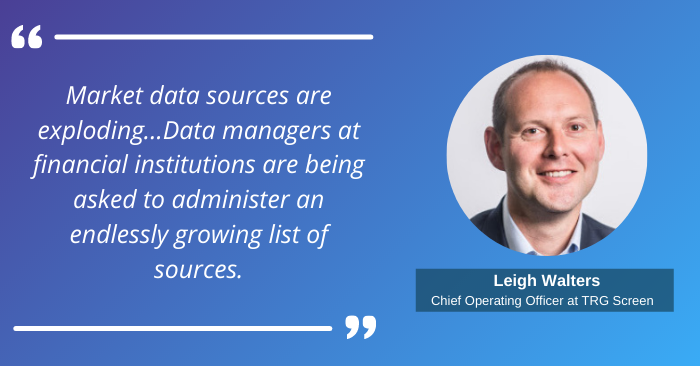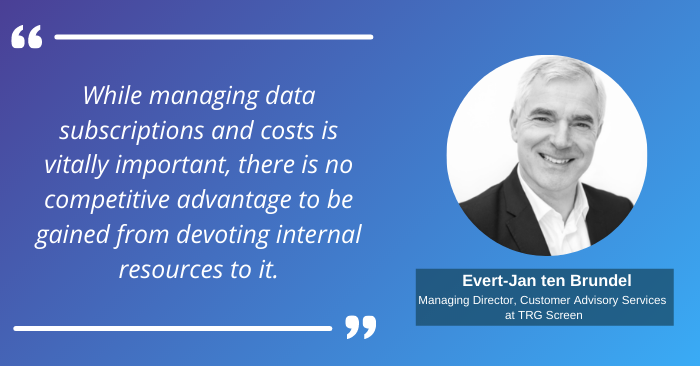All this is happening as market data teams – hard-pressed at the best of times – are dealing with new types of financial information and questions about whether staff working from home are always compliant with license agreements.
Yet 2022 promises to be a year of innovation in finance, an opportunity to accelerate digital transformation and to relieve the numerous potential headaches.
It’s early days, but here are five themes for data managers to keep an eye on.
Five themes to watch in ever-changing data market
➡ Increasingly complex data poses risks for unwary➡ “The Great Resignation”, staffing and admin overload
➡ Post-Covid inflation highlights need to curb costs
➡ Hybrid workforce brings compliance headaches, weighty admin burden
➡ Managed services market forecast to grow
Complexity of data and licensing 😖
During the pandemic, financial institutions widened their search for data from traditional vendors, such as Bloomberg and Refinitiv, to subscribe to services from exchanges and other execution venues. Hunting for an edge, a growing number also acquired so-called “alternative data”, which might measure traffic density or retail footfall.
“Market data sources are exploding,” said Leigh Walters, Chief Operating Officer at TRG Screen, a leader in enterprise data subscription management. “Data managers at financial institutions are being asked to administer an endlessly growing list of sources.”

With these multiple sources and subscriptions, reporting who is using what data is time-consuming and, if mistakes are made, costly. Exchanges and vendors have different requirements over what needs reporting and how. Meanwhile, exchange policies are changing, particularly as regards non-display and derived data and data usage by apps.
In this climate, which shows no sign of changing in 2022, keeping track of users’ data consumption, and of whether they are complying with the terms of the vendor’s license is vital. Some licensing agreements, designed with office working in mind, may not allow data consumption on multiple sites, including a staff member’s kitchen table.
Nor are subscriptions and licenses limited to data. Firms big and small are increasingly taking more and more services on regular subscription, such as computer software, periodicals and research, each generating invoices to pay and renewal dates to be aware of.
“The Great Resignation”, staffing and admin overload📚
How far the financial services industry has been impacted by the mass loss of jobs during the pandemic is open to debate. Research by Ian Cook published in the Harvard Business Review suggests banks saw fewer resignations last year than in 2020. Other surveys point to a high rate of churn.
Deloitte, in its 2022 banking and capital markets outlook, warns of ”an escalating war for talent” and says, “Employees, for the first time in decades, appear to have the upper hand, especially in sought-after positions.”
So, if an experienced member of a relatively small data team were lured away, it could be expensive to replace the lost skills. That chimes with the view of TRG Screen and others that data managers face an ever-increasing admin burden that leaves little time and energy for higher-value projects.
Dataflation? 🧨
Will the explosion in data sources be mirrored by another increase in data spending? At last count, spending on market data rose 4.7 percent to $37.3 billion as remote working boosted data demand, according to an influential annual report by Burton-Taylor International consulting.
The latest Burton-Taylor survey of market data professionals expects growth in the industry in 2022 to outpace the five-year average. The main drivers are the growing acceptance of cloud-tech to manage data, followed increased use of AI/ML (artificial intelligence/machine learning) to extract intelligence from data.
The survey confirmed that “advances in technology and a seemingly unquenchable thirst for information continue to fuel rising demand for, and spending on, market data”.

Consumer prices are rising fast in rich countries, partly due to a surge in demand on post-pandemic recovery and to hitches in global supply chains. Expectations central banks will raise interest rates significantly has pushed up market and rates higher.
The Cboe VIX volatility index hit its highest since November 2020 in late January on geopolitical jitters and concerns that central bank rate rises might sap investor confidence.
Higher rates and volatility should be good for banks but some analysts worry the end may be in sight for the cheap funds that boosted asset prices and bank profits.
In its 2022 outlook for banking and capital markets, Deloitte found that optimizing costs was a high priority of the finance executives it surveyed, although 80 percent also expected spending to rise.
Data costs will be in the spotlight. Britain’s Financial Conduct Authority said in January it would look at whether limited competition in markets for benchmarks and indices, credit ratings and wholesale trading data was raising investors’ costs and restricting their choices.
Digital transformation accelerates 💻
A Coalition Greenwich survey of financial professionals commissioned by Google Cloud, published in September, found that 93 percent of exchanges, trading systems and data providers offered cloud-based data and services and that 100 percent planned to offer new cloud services, including in derived data, in the coming year. Buy-side firms use more cloud-deployed data than the sell side but both intended to up consumption.
Half of exchanges, trading systems and data providers were offering data products and services driven by AI, with 42 percent of them planning to launch trading execution and analytics services.
Expect to hear more about DeFi (decentralized finance) in 2022.
The Pyth Network, supported by high-speed trading companies, plans to offer high quality trading data over blockchain technology. “The Pyth Network is a next-generation oracle solution that aims to bring this valuable financial data to the general public. The network does so by incetivizing market participants…to share the price data collected as part of their existing operations,” Pyth said. A game-changer for market data distribution?
Growth of managed services ⬆
The global managed services market is expected to grow to $354.8 billion in 2026 from $242.9 billion in 2021, says B2B research firm MarketsandMarkets. Growth will be driven by factors including a desire for secure infrastructure, cost and the need for regulatory compliance.
The same trend is evident in the financial data market. (Have you also seen our blog: Surviving the market data avalanche?)
The same trend is evident in the financial data market. “While managing data subscriptions and costs is vitally important, there is no competitive advantage to be gained from devoting internal resources to it.” said Evert-Jan ten Bundel, Director, Customer Delivery Services at TRG Screen. He said that adopting managed services can help firms stay on top of their vendor relationships and adopt a more strategic approach to information services procurement.

That could be a be a comfort to some data managers. The coming year will be packed with new challenges, just as 2021 (and every previous year) was. At the same time, products to help make sense of the inevitable growth in complexity of the market data universe are becoming more sophisticated.
Whether it’s monitoring data usage and spending, declarations to exchanges, license management or reconciliation of invoices, there is a solution out there.
TRG Screen also offers its suite of data usage and cost optimization products via managed services, whether the client wants to hand over invoice processing or the entire gamut of market data and information subscriptions administration.
Using other TRG Screen products, such as its ADS declaration tool, takes the pain out of declaring data usage even if policies change. Processes are automated by overseen expert market data analysts; clients say handing the task over to ADS can save 6%-8% of their market data spend.
The complexity of license inventory management becomes a breeze. Vendor agreements are updated and the allocation of licenses to users and apps is monitored and reported.
The admin burden is lifted, savings are made, and managers have more time to devote to ensuring the business makes the most of the best possible data. Easy.
Want to learn more on how a managed services approach could help your firm? 👇🏼






